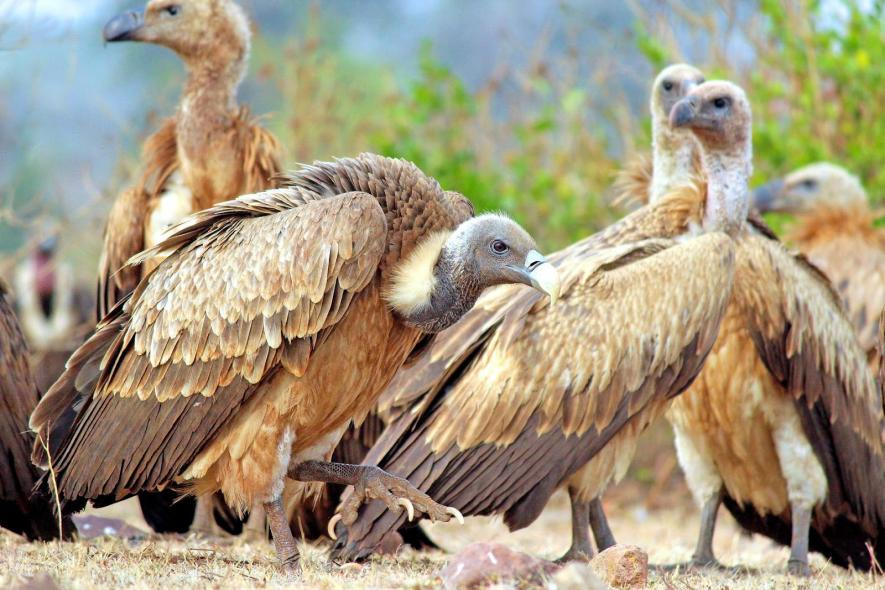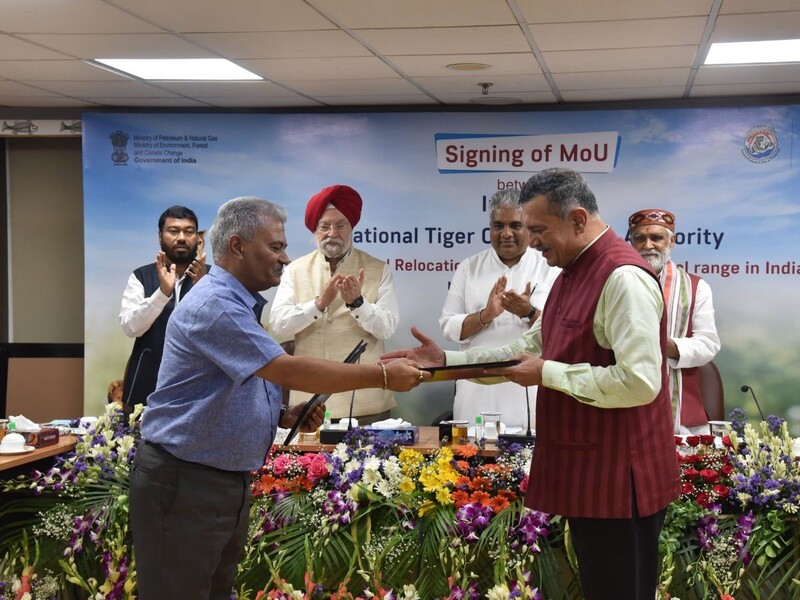Himalayan birds at higher risk of losing unique traits: Study (GS Paper 3, Environment)

Why in news?
- Globally, birds are already facing extinction threats due to climate change. Species loss could further lower diversity in morphological traits among remaining birds
- Recently, a new study has estimated that Himalayan birds are more likely to lose traits that are unique to them than other birds inhabiting other parts of the world.
Vultures:
- The loss of vultures might play some role in lowering the diversity in morphological traits such as beak and body size, shape, and structure in the Himalayan region.
- Vultures, which are large-bodied and rely solely on the meat and flesh of dead or decaying organisms for food, are the most imperilled group of birds.
- These birds fill distinct areas of morphospace, a mathematical representation that shows how diversity in bird shape and size evolves.
- Vultures provide vital ecosystem services by removing decaying carcasses, which otherwise could increase the direct transmission of infectious diseases and increase populations of opportunistic scavengers (dogs and rats) that spread rabies and bubonic plague.
Basis of study:
- Losing endangered species leads to species being more similar to each other in terms of their morphology. They collected data on morphological traits from museum collections of 8,455 bird species.
- They used statistical modelling to determine whether extinction decreases structural diversity among remaining birds. The model predicted that loss in structural diversity could impact birds showing extreme features such as the smallest and the largest birds.
Key Findings:
- Species threatened with extinction tend to possess more extreme trait combinations than those not at risk of extinction.
- Specialist birds have a limited diet and can dwell in only specific habitats, according to researchers.
- In forests with low morphological diversity, we might expect, on average, to see more seed-eating or generalist species that have a more ordinary beak shape and are medium to small in size.
- Mynas or house sparrows are likely to dominate. They are generalist birds, known to have a more flexible diet and can inhabit a range of habitats.
Risk zone:
- The Himalayan mountains and foothills are at particular risk and it's likely that the loss of trait diversity will be considerable.
- East Asia and the moist forests of South Vietnam and Cambodia are also vulnerable, the study found.
Conclusion:
- The global extinction crisis will lead to widespread losses of morphological diversity above that expected by species loss alone.
Small Satellite Launch Vehicle (SSLV)
(GS Paper 3, Science and Tech)
Why in news?
- The Indian Space Research Organisation (ISRO) is all set to launch its Small Satellite Launch Vehicle (SSLV) from Sriharikota's Satish Dhawan Space Centre in Andhra Pradesh.
It was being delayed for multiple times, owing to the Covid-19 pandemic.

EOS-02:
- The rocket will carry Earth Observational Satellite (EOS-02) Mission to space.
- The EOS-02 mission is a technology demonstration satellite for various new technologies with applications that include agriculture, forestry, geology, and hydrology.
What is SSLV?
- The SSLV is third launch vehicle of the research organisation after Polar Satellite Launch Vehicle (PSLV) and Geosynchronous Satellite Launch Vehicle (GSLV).
- The Small Satellite Launch Vehicles have been designed to attract the emerging small satellite market and provide launch-on-demand services to domestic and foreign customers.
- SSLV will free ISRO’s workhorse Polar Satellite Launch Vehicle for bigger missions. The maiden mission is aimed to demonstrate the technological advancement made by ISRO and its capability to deliver smaller payloads into low Earth Orbit.
- SSLV is a brainchild of current ISRO chief S Somnath, who has been known for his rocket wizardry worldwide.
Key features:
- The SSLV has been designed to launch a payload weighing 500 kg to a 500-kilometer planar orbit. By comparison, the PSLV can take up to a 1,750-kilogram payload into the Sun Synchronous Orbit at 600 km altitude.
- Apart from the capability to launch up to 500 kg of satellite mass, the SSLV will have the option of multiple satellite mounting options for nano, micro, and small satellites.
- Weighing 110-tons, the three-stage all-solid stage vehicle is the smallest in the ISRO arsenal of launchers and ISRO is marketing it as one with the quickest turnaround. The rocket can be assembled and integrated in just 72 hours against other launch vehicles, which takes close to two months to reach the launch pad from the assembly building.
Funding:
- The Centre has allocated Rs 169 crores for the development of the project, which is to cover the development & qualification of the vehicle systems and the flight demonstration through three development flights, SSLV-D1, SSLV-D2, and SSLV-D3.
- The Ministry of Science & Technology has in the past said that the SSLV has been primarily envisaged to build a cost-effective launch vehicle with high launch frequency and quick turnaround capability in order to cater to the growing opportunity in the global launch services market for small satellites.
Way Forward:
- In its maiden flight, the new SSLV will carry AzaadiSat, which is built by 750 girl students of 75 schools across India.
- It will also carry one of India's Earth Observation Satellites EOS 2.
Indian Oil signs MoU with NTCA for transcontinental relocation of ‘cheetah’
(GS Paper 3, Environment)
Why in news?
- Indian Oil signed an MoU with National Tiger Conservation Authority (NTCA) for transcontinental relocation of ‘Cheetah’ in its historical range in India.
- This is in continuation with the MoU signed on 20th July 2022 between Government of India and Government of the Republic of Namibia on wildlife conservation and sustainable biodiversity utilization, for establishing the cheetah into the historical range in India.
Details:
- Indian Oil will be contributing Rs.50.22 crore in 4 years for the project components viz. Cheetah Introduction, its Habitat Management & Protection, Eco Development, Staff Training and Veterinary Healthcare.
- Indian Oil is the first corporate which has come forward to support the “Project Cheetah” under CSR, as the project has not only national importance but is also essential for balancing the ecosystem.

Conserving India's natural habitat and heritage:
- Cheetah restoration will be part of a prototype for restoration of original cheetah habitats and their biodiversity, helping to stem the degradation and rapid loss of biodiversity.
- This project is in sync with Indian Oil's strong environmental conscience and aligns with the company's focus on conserving India's natural habitat and heritage.
- Indian Oil adopted Indian Single Horned Rhino as its mascot in 2021 and, since then, has been at the forefront of India's Rhino conservation endeavors.
Reintroduction of Cheetah:
- Under this project, a source population of 8-10 Cheetahs will be flown in from Namibia and South Africa and will be introduced at Kuno National Park, Madhya Pradesh.
- The subspecies of Cheetah which got extinct in India was Asiatic Cheetah (Acinonyx jubatus venaticus) and the subspecies being introduced back in the country is African Cheetah (Acinonyx jubatus jubatus). Research has shown that genes of these two subspecies are the same.
- It is a national project involving National Tiger Conservation Authority (NTCA), Govt. of India and the State Govt. of Madhya Pradesh.
- NTCA is the nodal agency authorized by MoEF&CC for funding, supervision and hand holding. Indian Oil will contribute its CSR funds to NTCA, which shall co-ordinate with the State Govt. of Madhya Pradesh and other agencies involved in the project.
Anaemia Mukt Bharat (AMB) strategy
(GS Paper 2, Governance)
Context:
- The Government of India implements Anaemia Mukt Bharat (AMB) strategy under POSHAN Abhiyaan with the target for reducing anaemia in the six population groups –
- Children (6-59 months),
- Children (5-9 years),
- Adolescents girls and boys (10-19 years),
- Pregnant women,
- Lactating women and
- Women of Reproductive Age (WRA) group (15-49 years) in life cycle approach.

Major interventions:
Some of the major interventions by Ministry of Health and Family Welfare (MoHFW) to address anaemia under AMB include:
- Prophylactic Iron and Folic Acid Supplementation.
- Deworming.
- Intensified year-round Behaviour Change Communication (BCC) Campaign and delayed cord clamping.
- Testing of anaemia using digital methods and point of care treatment.
- Addressing non-nutritional causes of anaemia in endemic pockets with special focus on malaria, hemoglobinopathies and fluorosis.
- Convergence and coordination with line department and other ministries.
- Engaging National Centre of Excellence and Advanced research on Anaemia Control for capacity building of health care providers.
- Monitoring progress in States/UTs using Anaemia Mukt Bharat Dashboard.
Statists on prevalence of anaemia:
- As per the fifth round of National Family Health Survey (NFHS), conducted by MoHFW during the year 2019-21, the prevalence of anaemia among women age 15-49 is 57.0 percent as compared to 53.1 percent in NFHS-4, (2015-16).
- However, thirteen (13) States/UTs namely Andhra Pradesh, Andaman and Nicobar Island, Arunachal Pradesh, Chandigarh, Dadra and Nagar Haveli and Daman and Diu, Haryana, Himachal Pradesh, Lakshadweep, Meghalaya, NCT of Delhi, Tamil Nadu, Uttar Pradesh and Uttarakhand have reported decline in prevalence of anaemia among women age 15-49 in NFHS-5 as compared to NFHS-4.





